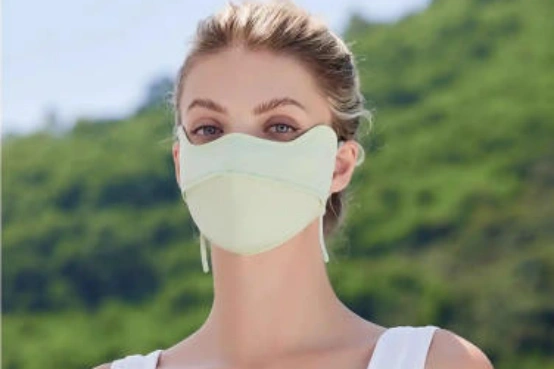In the scorching summer, ultraviolet rays under the sun may not only cause damage to the skin but also affect our health. As people pay more and more attention to sun protection, masks, as daily protective items, have gradually been endowed with a new function - sun protection. However, which color of mask provides the best sun protection? This problem troubles many consumers. This article will explore the relationship between mask color and sun protection effect from a scientific perspective and provide practical suggestions for consumers.

I. The Relationship between Mask Color and Sun Protection Effect
To understand the relationship between the color of masks and their sun protection effect, it is first necessary to clarify the damage that ultraviolet rays (UV) cause to the skin. Ultraviolet rays are mainly divided into two types: UVA and UVB. Among them, UVA can penetrate deep into the dermis of the skin, accelerating skin aging and causing wrinkles and spots. UVB, on the other hand, mainly acts on the surface of the skin, causing redness, swelling, burns and even skin cancer. Therefore, sun protection mainly aims to prevent damage to the skin caused by UVA and UVB rays.
The sun protection effect of masks mainly depends on their material and color. In terms of material, generally speaking, masks that are closely woven and of moderate thickness offer better sun protection. In terms of color, masks of different colors have varying abilities to absorb and reflect ultraviolet rays.
Dark-colored masks: Dark-colored masks such as black and dark blue have a stronger ability to absorb ultraviolet rays. When sunlight shines on a dark mask, most of the ultraviolet rays are absorbed by the mask, thereby reducing the direct exposure of ultraviolet rays to the skin. However, wearing a dark mask for a long time may cause the mask temperature to rise, exerting a certain degree of thermal pressure on the skin.
Light-colored masks: Light-colored masks such as white and light blue have a strong ability to reflect ultraviolet rays. When sunlight shines on light-colored masks, some ultraviolet rays will be reflected back into the air by the masks, thereby reducing the exposure of ultraviolet rays to the skin. In addition, light-colored masks are relatively breathable and more comfortable to wear.
II. How to Choose a Mask with Good Sun Protection Effect
Material selection: Give priority to choosing masks that are closely woven and of moderate thickness to ensure good sun protection. Avoid choosing overly thin or sparse masks to prevent affecting the sun protection effect.
Color selection: Between light and dark masks, light masks may be more suitable for use in summer. Because light-colored masks have a stronger ability to reflect ultraviolet rays, they can reduce the exposure of ultraviolet rays to the skin. Meanwhile, light-colored masks are relatively breathable and more comfortable to wear. Of course, if one prefers dark masks, they can also choose dark masks, but it is necessary to pay attention to changing them in time to keep the masks clean and hygienic.
Sun protection factor: Some professional sun protection masks will indicate the Sun Protection Factor (UPF). Consumers can choose masks that suit them based on the sun protection factor. Generally speaking, the higher the UPF value, the better the sun protection effect of the mask. 4. Other factors: Besides the material and color, the wearing method and size of the mask also need to be taken into consideration. Make sure the mask fits the facial skin closely to prevent ultraviolet rays from entering through the edges of the mask.
III. Precautions for Using Sun Protection Masks
Regular replacement: Sun protection masks may lose their sun protection effect after long-term use, so they need to be replaced regularly. It is recommended to change your mask once a day to maintain its good sun protection effect.
Avoid prolonged exposure to the sun: Although sun-protective masks have a certain sun protection effect, prolonged exposure to the sun can still cause damage to the skin. Therefore, when engaging in outdoor activities, it is recommended to avoid prolonged exposure to the sun as much as possible, and to replenish water and apply sunscreen in a timely manner.
Pay attention to moisturizing: Sun-protective masks may make the facial skin feel dry, so it is necessary to pay attention to moisturizing. You can choose sunscreen or skin care products with moisturizing functions to nourish your skin.
Avoid contact with chemicals: Sun protection masks should avoid contact with chemicals to prevent damage to their sun protection effect or irritation to the skin.
To sum up, the color of masks has a certain relationship with their sun protection effect. Light-colored masks have a stronger ability to reflect ultraviolet rays and are more suitable for use in summer. Dark-colored masks have a stronger ability to absorb ultraviolet rays, but they may cause the mask temperature to rise. When choosing a sun-protective mask, in addition to considering the color, it is also necessary to pay attention to factors such as the material of the mask and its sun protection factor. At the same time, when using a sun-protective mask, it is necessary to pay attention to regular replacement, avoid prolonged exposure to the sun, keep it moisturized and avoid contact with chemical substances, etc. By scientifically choosing and correctly using sun-protective masks, we can better protect our skin from the damage of ultraviolet rays.


 29-Aug--2025
29-Aug--2025